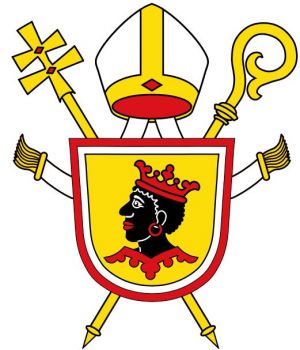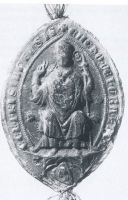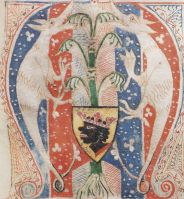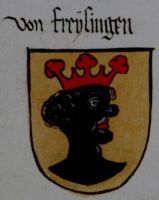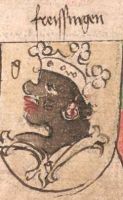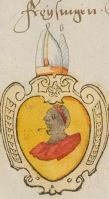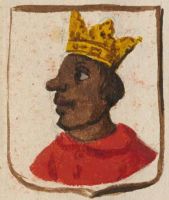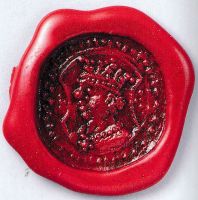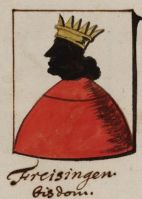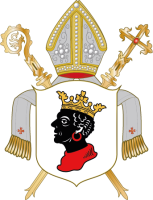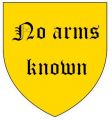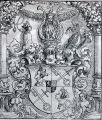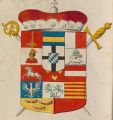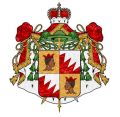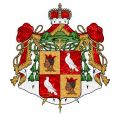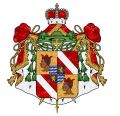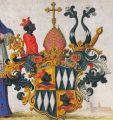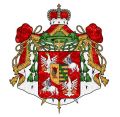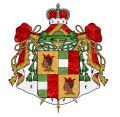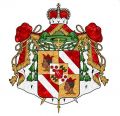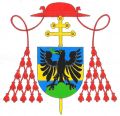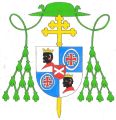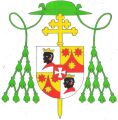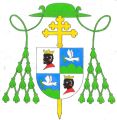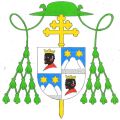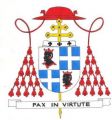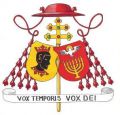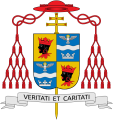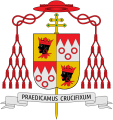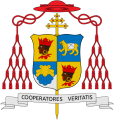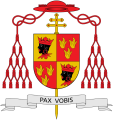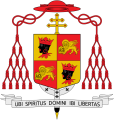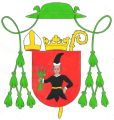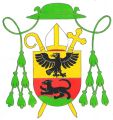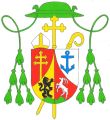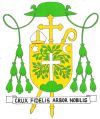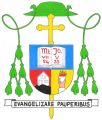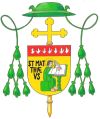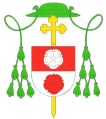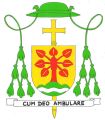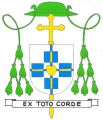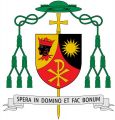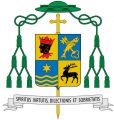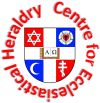Archdiocese of München-Freising
ARCHDIOCESE OF MÜNCHEN-FREISING (Archidioecesis Monacensis et Frisingensis)
Country : Germany
Denomination : Roman Catholic
Established : 739 as Diocese of Freising
Elevated and renamed in 1818 to Archdiocese of München-Freising
Added 1818 Diocese of Chiemsee
Official blazon
Origin/meaning
The crowned head as symbol for the diocese appears for the first time on the seals of Bishop Emicho in 1285 in a small shield at the base of his seal. As colours are not known, it is unclear whether it is really a Moor's head. The Moor is often identified as the patron saint of the diocese, St. Corbinian, however, he was not black and all old images of the saint used by the bishops, showed him facing not en profil. He is also never shown with a crown.
More likely is the theory that Bishop Ermicho wanted to show that he is only below the German King, symbolised by the crown, and not under the rule of the Dukes of Bavaria, with whom he was in a territorial conflict.
The first coloured image appears in a book from Bishop Konrad (1314-1322) and clearly shows a crowned Moor. This image has never changed since. Even though there has been a lot of research and a number of theories, it is still not clear why a Moor's head was chosen and/or whether already the head on the seal of Bishop Ermicho was already a Moor.
The most accepted theory is the following; under Bishop Konrad the Moor was used as a symbol to mark the property of the diocese and was mentioned as a Caput Aethiopis, or the Head of an Ethiopian. This, in turn, may refer to a Biblican theme where Ethiopians (or Ethiopian Kings) were seen as curators or protectors of treasure. A head of a crowend Ethiopian thus could be used as a symbol of property or treasure.
A second theory is that the head refers to the people that are still not Christian, and have not seen the light, i.e. shown as black. This may refer to the missionary activity of the bishops in their Eastern possessions in what is now Austria and Slovenia.
It is also speculated that these theories are combined : Bishop Ermicho wanted to show that he is under the King alone, that he acts as a missionary and at the same time it was used to protect his treasure. Probably we will never find out the actual reason for using the Moor.
The colours have historically been with a golden shield, but after the renaming and move from Freising to München in 1818 the arms were generally seen in the colours of München, silver and black. Only in 2013 the Archdiocese reverted to the historical colours. The Archbishops already reverted tp the historical colours in the early 20th century.
After 1803 when the wordly possessions of the different ecclesiastical rulers (bishops, abbeys..) were confiscated by the Bavarian State (secularisation) it was suggested to replace the arms with the Moor, as these also referred to the territories held by the bishops. Several new designs from 1821 focussed on the patron saints of the diocese. St. Mary and St. Corbinian, see image below, but were never approved or adopted.
The arms in the Wapen- en Vlaggenboek van Gerrit Hesman (1708)
Arms of Bishops
- No image
Konrad IV. von Klingenberg (1324-1340)
- No image
Johannes II. Hake (1341-1349)
- No image
Albert II. von Hohenberg (1349-1359)
- No image
Paul von Jägerndorf (1359-1377)
- No image
Leopold von Sturmberg (1378-1381)
- No image
Berthold von Wehingen (1381-1410)
- No image
Konrad V. von Hebenstreit (1411-1412)
- No image
Hermann von Cilli (1412-1421)
- No image
Nikodemus della Scala (1422-1443)
- No image
Heinrich II. Schlick (1443-1448)
- No image
Johannes III. Grünwalder (1448-1452)
- No image
Johann IV. Tulbeck (1453-1473)
Sixtus von Tannberg (1474-1495)
- No image
Ruprecht von der Pfalz (1495-1498)
Philipp von der Pfalz (1498-1541)
- No image
Heinrich von der Pfalz (1541-1552)
- No image
Leo Lösch von Hilkertshausen (1552-1559)
- No image
Moritz von Sandizell (1559-1566)
Ernst von Bayern (1566-1612)
Stephan von Seiboldsdorf (1612-1618)
Veit Adam von Gepeckh (1618-1651)
Albrecht Sigismund von Bayern (1652-1685)
- No image
Joseph Clemens von Bayern (1685-1694)
Johann Franz Eckher von Kapfing und Liechteneck (1695-1727)
Johann Theodor von Bayern (1727-1763)
Clemens Wenzeslaus von Sachsen (1763-1768)
Ludwig Joseph von Welden (1768-1788)
Maximilian Prokop von Toerring-Jettenbach (1788-1789)
Joseph Konrad von Schroffenberg (1789-1803)
Arms of Archbishops
Lothar Anselm von Gebsattel (1821-1846 )
Karl August von Reisach (1846-1856)
Gregor von Scherr (1856-1877)
Anton von Steichele (1878-1889)
Antonius von Thoma (1889-1897)
Franz Joseph von Stein (1897-1909)
Franziskus von Bettinger (1909-1917)
Michael von Faulhaber (1917-1952)
Joseph Wendel (1952-1960)
Julius August Döpfner (1961-1976)
Joseph Ratzinger (1977-1982)
Friedrich Wetter (1982-2007)
Reinhard Marx (2008-present)
Arms of Auxiliary bishops
- No image
Johannes Frey (1457-1474)
- No image
Johannes Berger (1475-1481)
- No image
Erasmus Berchinger (1482-1483)
- No image
Ulrich Pramberger (1484-1494)
- No image
Johannes Gropengeter (1499-1508)
- No image
Mathias Schach (1495-1515)
- No image
Konrad Mair (1517-1522)
- No image
Augustin Mair (1423-1427)
- No image
Johann Peter Stoll (1529-1548)
- No image
Oswald Fischer (1548-1568)
- No image
Sebastian Haidlauf (1569-1580)
- No image
Bartholomäus Scholl (1581-1629)
- No image
Johann Fiernhammer (1630-1663)
- No image
Johann Kaspar Kühner (1665-1685)
- No image
Simon Judas Thaddäus Schmidt (1687-1691)
- No image
Johann Sigmund Zeller von und zu Leibersdorf (1692-1729)
- No image
Johann Ferdinand Joseph von Boedigkeim (1730-1756)
- No image
Franz Ignaz Albert von Werdenstein (1756-1766)
- No image
Ernest Johann Nepomuk von Herberstein (1767-1785)
Johann Nepomuk von Wolf (1788-1802)
Franz Ignaz von Streber (1821-1841)
Johann Baptist von Neudecker (1911-1926)
- No image
Alois Hartl (1921-1923)
Michael Buchberger (1923-1927)
Johann Baptist Schauer (1928-1942)
Anton Scharnagl (1943-1955)
Johannes Neuhäusler (1947-1973)
Ernst Tewes (1968-1984)
Matthias Defregger (1968-1990)
Heinrich von Soden-Fraunhofen (1972-1993)
- Did not use arms
Franz Schwarzenböck (1972-1998)
- Did not use arms
Engelbert Siebler (1986-2012)
Bernhard Haßlberger (1994-present)
Franz Dietl (1998-2010)
Wolfgang Bischof (2010-present)
Rupert Graf zu Stolberg-Stolberg (2016-present)
Religious or Ecclesiastical heraldry portal
This page is part of the Ecclesiastical heraldry portal |
Heraldry of the World |
|
Catholic heraldry
|
Other Christian churches Other religions
|
Contact and Support
Partners:
Your logo here ?
Contact us
© since 1995, Heraldry of the World, Ralf Hartemink 
Index of the site
